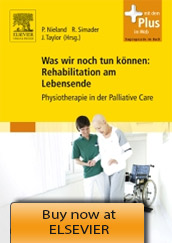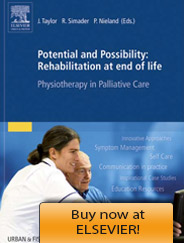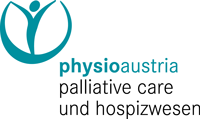

"Potential and Possibility: Rehabilitation at end of life.
Physiotherapy in Palliative care"
Eds: Taylor, Simader, Nieland
English
Table of Contents
| 1 | Approaching the specialty of physiotherapy in palliative care |
|---|---|
| 1.1 | Definition of palliative care and end of life care |
| 1.2 | Who is the palliative care physiotherapist? |
| 1.2.1 | Professional profile: The value of the physiotherapist in palliative care |
| 1.2.2 | Clinical skills and knowledge |
| 1.2.3 | Education opportunities for physiotherapists in palliative care |
| 1.2.4 | Conclusion |
| 1.3 | From symptom control to rehabilitation: Physiotherapy approaches to end of life care |
| 1.3.1 | Physiotherapy then and now |
| 1.3.2 | Current context and aim of intervention |
| 1.3.3 | Patient goals and outcomes |
| 1.3.4 | Understanding the patient in depth |
| 1.3.5 | Team-working |
| 1.3.6 | The collaborative physiotherapy model |
| 1.3.7 | Physiotherapy at end of life |
| 1.3.8 | Alternative contexts for physiotherapy intervention |
| 1.3.9 | The educational role of the physiotherapist |
| 1.3.10 | Innovation |
| 1.3.11 | Conclusion |
| 1.4 | The right time for physiotherapy: Is there a 'too late' or a 'too early'? |
| 1.4.1 | Early referral to physiotherapist |
| 1.4.2 | Late physiotherapeutic interventions |
| 1.4.3 | The patient journey |
| 1.4.4 | Determining the right time for physiotherapy |
| 1.4.5 | Conclusion |
| 1.5 | Physiotherapy at end of life: Patient's perspectives |
| 1.5.1 | Patients' needs and priorities |
| 1.5.2 | Patients' thoughts on physiotherapy in palliative care |
| 1.5.3 | How can we learn from our patients? |
| 1.5.4 | The goldfish bowl |
| 1.5.5 | What have we learnt from our patients this far? |
| 1.5.6 | Three personal testimonies |
| 1.6 | Physiotherapy Students in Palliative Care |
| 2 | Physiotherapy and medical aspects |
| 2.1 | Clinical reasoning |
| 2.1.1 | Clinical reasoning in physiotherapy |
| 2.1.2 | Clinical reasoning in physiotherapy in palliative care |
| 2.1.3 | Conclusions |
| 2.2 | Pain |
| 2.2.1 | Case study |
| 2.2.2 | Pain |
| 2.2.3 | Spinal cord compression |
| 2.2.4 | Conclusions |
| 2.2.5 | Reflective questions |
| 2.3 | Respiratory symptoms: dyspnoea/breathlessness from airway obstruction and impaired oxygen capacity |
| 2.3.1 | Case study |
| 2.3.2 | Airway obstruction in the palliative care setting |
| 2.3.3 | Impaired oxygen capacity in the palliative care setting |
| 2.3.4 | Medication for breathlessness and associated symptoms |
| 2.3.5 | Summary |
| 2.3.6 | Reflective questions |
| 2.4 | Breathlessness and fear |
| 2.4.1 | Case study |
| 2.4.2 | Context of breathlessness at end of life |
| 2.4.3 | Effective physiotherapy strategies for managing breathlessness |
| 2.4.4 | Context of anxiety and panic in the breathless patient |
| 2.4.5 | A physiotherapy approach to managing anxiety and panic in the context of breathlessness |
| 2.4.6 | Conclusions |
| 2.4.7 | Reflective questions |
| 2.5 | Lymphoedema |
| 2.5.1 | Case study |
| 2.5.2 | Lymphatic system and potential disorders |
| 2.5.3 | Physiotherapy for lymphoedema in the palliative care setting |
| 2.5.4 | Reflective questions |
| 2.6 | Fatigue and weakness |
| 2.6.1 | What is fatigue? |
| 2.6.2 | Case study |
| 2.6.3 | Physiotherapy and fatigue |
| 2.6.4 | Conclusions |
| 2.6.5 | Reflective questions |
| 2.6.6 | Group work in palliative care |
| 2.7 | Anxiety in the context of palliative physiotherapy |
| 2.7.1 | Case study |
| 2.7.2 | Anxiety in palliative care patients |
| 2.7.3 | Specific and practical assessment methods related to anxiety |
| 2.7.4 | Physiotherapeutic interventions related to anxiety |
| 2.7.5 | Conclusions |
| 2.7.6 | Reflective questions |
| 2.8 | Dementia |
| 2.8.1 | Development and types of dementia |
| 2.8.2 | Diagnosing dementia |
| 2.8.3 | Dementia and the body |
| 2.8.4 | Principles of supportive physiotherapy in dementia |
| 2.8.5 | Patient cases and physiotherapeutic interventions |
| 2.8.6 | Conclusion |
| 2.8.7 | Reflective questions |
| 2.9 | Physiotherapy in paediatric palliative care |
| 2.9.1 | Features of paediatric palliative care |
| 2.9.2 | Principles of physiotherapy with children and adolescents in the palliative care setting |
| 2.9.3 | Special features of therapy in different situations |
| 2.9.4 | Case study |
| 2.9.5 | Conclusions |
| 2.9.6 | Reflective questions |
| 2.10 | Physiotherapy in the terminal phase |
| 2.10.1 | Physiotherapy at end of life – yes or no? |
| 2.10.2 | Physiotherapeutic interventions in the terminal phase |
| 2.10.3 | Conclusions |
| 2.10.4 | Reflective questions |
| 3 | Psycho-social aspects |
| 3.1 | Communication in palliative care: an introduction |
| 3.2 | 'Of sad lions that roar' and handling strong emotions |
| 4 | Ethical, spiritual and cultural aspects |
| 4.1 | Ethics and ethical reasoning in palliative physiotherapy |
| 4.2 | The interface between function and meaning |
| 4.2.1 | What does society tell us about our bodies? |
| 4.2.2 | To what is the healthy body an antidote? |
| 4.2.3 | Function and meaning |
| 4.2.4 | The use of narrative: A key approach for the physiotherapist |
| 4.2.5 | Conclusion |
| 4.2.6 | Reflective questions |
| 4.3 | With respect and openness: intercultural competence in palliative physiotherapy |
| 5 | "Self care" for Physiotherapists |
| 5.1 | "How am I really feeling?" – questions and suggestions for (self-)supervision |
| 5.2 | Closeness and distance, to touch and be touched; the physiotherapeutic dynamic |





